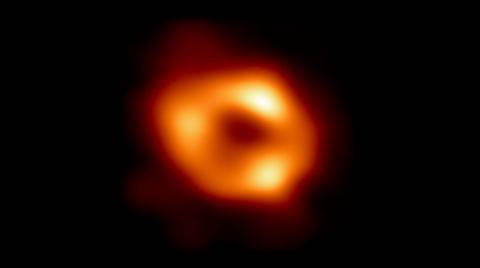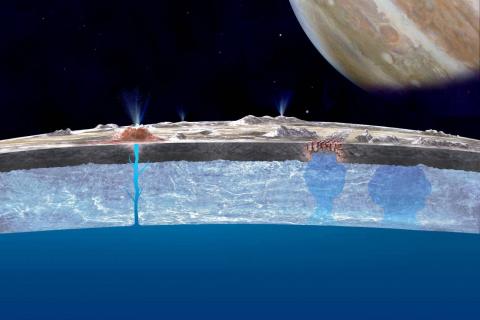Reactions to the first image of the supermassive black hole at the centre of the Milky Way galaxy
An international team of researchers has captured the first image of Sagittarius A*, the supermassive black hole at the centre of the Milky Way. The results are published today in a special issue of The Astrophysical Journal Letters.

Gonzalo J. Olmo - Agujero negro
Gonzalo J. Olmo
Professor of the Department of Theoretical Physics & IFIC of the University of Valencia - CSIC
Diego Rubiera-García
Talent Researcher in the Department of Theoretical Physics of the Complutense University of Madrid
Black holes do not emit light of their own, but the stars orbiting around them and the matter they devour give us clues about what these giants of the universe are like. We have learned a lot about Sagittarius A*, the black hole at the center of our galaxy, by studying the orbits of stars moving around it. These stars describe very peculiar orbits around... nothing, nothing that we can see or that emits light or other observable radiation. But these orbits can only be explained if we accept that in that region there is an invisible, very compact object with a mass comparable to that of four million suns.
Today the Event Horizon Telescope (EHT) collaboration shows us the first images of the region where these 4 million solar masses are concentrated. As with their previous announcement in April 2019, where they presented the first images of the supermassive black hole in the galaxy M87, what they show us now is also compatible with what Einstein's theory tells us about what black holes should look like. Around a dark spot, from which no light is coming out, we observe a luminous disk of matter at very high energy. It is an accretion disk, something like Saturn's rings but composed of nuclear matter at very high temperature that has been accumulating around the central object (black hole) and is waiting to be devoured at some point. It is thanks to this incandescent matter, which moves at very high speeds attracted by the central object, that we can observe the central dark region corresponding to the black hole.
If of Saturn's rings we can only see the part between the planet and us, because the other part is hidden behind the planet, in the case of Sagittarius A* the intense gravity manages to bend the light rays (and radio waves and X-rays) in such a way that the entire accretion disk is visible, both the part closest to us and the part behind us, as well as the part above and below. The resulting image shows optical effects and deformations that are compatible with what would be expected from the intense gravity generated by an object of 4 million solar masses. Light can be bent by gravity and the images show that bending at its best.
To observe for the first time the image of the glowing masses orbiting in the regions closest to the black hole of our own galaxy, the Milky Way, is a luxury that history has reserved for us. This is a great example of what humanity can achieve by working together in peace and harmony. It takes great ingenuity to use an array of eight isolated antennas distributed around the planet to combine their signals and produce the equivalent of what an antenna the size of planet Earth would observe. Once this historic milestone has been reached, it is necessary to be even more daring, careful and patient to accumulate enough data to reconstruct the image that we have been able to contemplate today.
Beyond their artistic quality, since we are all excited to observe an incandescent plasma that will be devoured by a supermassive black hole, these images contain valuable scientific information that will help us to better understand the properties of matter under extreme conditions of pressure and temperature. We will also be able to test our physical theories about matter and gravity, because it is one thing if what we see looks like what we expect, and another if it is exactly that. Precision science is fundamental to advancing knowledge. Having the courage to risk initiating explorations of this caliber is within the reach of only a few. The EHT collaboration is the result of a bold combination of risky ideas and precision work of the highest level, implemented by some 300 people working side by side, day and night, for years.
The images brought to us today by the EHT are strikingly similar to the one they showed in 2019 of the black hole in the supermassive galaxy M87. Although that object is about a thousand times larger than the one observed today in the Milky Way, its resemblance to our 'little' black hole shows the universality of the physical principles describing these objects.
Juan García Bellido - agujero negro
Juan García Bellido
Research professor at the Institute of Theoretical Physics (UAM-CSIC)
It's exciting, I was expecting this three years ago. As always, when there is a big discovery there are a lot of questions to answer. One thing that surprises me is that, as we are positioned relative to the centre of the galaxy, we would expect to see the black hole gas disc perpendicular to us. Instead we see it tilted a little bit, and the reason for this tilt will have to be explained.
Another thing I expected, and we haven't seen, is a movie of the billions of images captured as the stars rotate, in minutes, around the black hole. The researchers have chosen one set of images, the sharpest ones, but in reality there are many, many images.
It remains to be understood whether the black hole is rotating, and the orientation of that axis of rotation.
Romano Corradi - agujero negro
Romano Corradi
Director of the Gran Telescopio Canarias (GTC)
When they presented the Event Horizon Telescope (EHT) result on M87 I found it to be one of the most striking (rather than important) results in observational astrophysics in the last decades. Because it is a picture, not a graph or any other kind of complicated data, which makes it straightforward for everyone to understand ("Because you saw me, Thomas, you believed...") and therefore to internalise that black holes really exist and are as Einstein predicted (although he himself was sceptical). Which is why the first thing for me is the potential that these images have in society.
This is certainly a global collaboration, where different countries and scientific communities (and disciplines other than physics) are collaboratively involved. Where practically all the facilities that can contribute something have come together.
At the Gran Telescopio Canarias there is no immediate implication of the new observations of Sagittarius A*, although the centre of our galaxy is an obvious target for any telescope, and as always the understanding of the black hole phenomenon at any scale (stellar, where the Gran Telescopio Canarias is obtaining important results, or galactic is based on many different kinds of studies.
I would say that in the case of Sagittarius A* the Event Horizon Telescope image will be the icing on a very big cake, thanks to all the previous studies, including of course the work of Nobel Laureate Reinhard Genzel with the telescopes of the European Southern Observatory, which I think is one of the most important observational results in modern astrophysics.
Romano Corradi is a member of the Advisory Committee of SMC Spain.
Roberto Emparan - Agujero negro EN
Roberto Emparan
Theoretical physicist and ICREA professor at the Institute of Cosmos Sciences of the University of Barcelona
This is a black hole whose existence was conjectured fifty years ago as an almost fanciful idea. Over time, the evidence in favor of this hypothesis has grown to become almost a certainty. The 2020 Nobel Prize (to Genzel and Ghez) was awarded for the discovery and observation of stars orbiting around an enormously massive and compact, but dark center. With the Event Horizon Telescope the observation of this object has been made in the most direct way possible: by its 'shadow' on the luminous matter surrounding it. The image is very similar to the previous one in 2019 of the black hole M87*.
To most these images may seem unimpressive: they are blurry and bear little resemblance to the pretty illustrations of black holes we see in popular magazines or movies. But, on reflection, it is impressive that this has been achieved - we can see black holes! The impressive technical and scientific development required, and the ability to collaborate internationally in a coordinated way to achieve this, are among the best reasons we have to be proud of humanity, even though in so many other ways we are so disappointing.
The images we have now have too little detail to reveal specific properties of these black holes, nor to accurately test Einstein's theory. But these images should be understood as a beginning: in the future, the images will become more concrete (and also more beautiful). The task has only begun.
For the moment, we can say that the similarity between the 2019 image of M87* and the current image of SgrA*, despite the huge differences between their sizes (the latter is 1000 times smaller than the former), indicates that the closest environment to the black hole is very similar regardless of the size of the black hole. Later observations will tell us much more about the properties of the matter around the black hole, and we will be able to tell whether this object is really what Einstein's theory predicts, or a more exotic 'impostor' or 'imitator'. Because, today, black holes have become the simplest and most conventional explanation for the historic discoveries of recent years. Black holes have definitely left the realm of the craziest science fiction to become the next-door neighbors we see and greet almost every day. Today's image shows us, in fact, our closest neighbor among the largest of these objects.
You've been a long time coming, but we can finally say, nice to meet you in person, SgrA*!
Juan Ramón Muñoz de Nova - Agujero negro EN
Juan Ramón Muñoz de Nova
UNA4CAREER postdoctoral researcher in the Condensed Matter Theoretical Physics Group of the Complutense University of Madrid
The observation is quite a milestone. From a technical point of view, it is the most conclusive observation of a black hole ever made and quite an experimental feat.
From a more theoretical point of view, this observation is of great interest because the observed results are still in agreement with the results predicted by Einstein's equations of General Relativity, formulated more than 100 years ago. This is very interesting because most tests of Einstein's equations have been performed for very weak gravitational fields. However, the observations made in this black hole, in whose center gravity is so intense that light cannot escape, are still described by Einstein's theory, which supports its validity even in these extreme regimes.
From a more general point of view, the observation is very interesting because, after all, this is precisely the black hole at the center of our galaxy.
Looking to the future, this observation opens the way to observe more black holes in detail and in a more systematic way, even making movies of their temporal evolution. This will allow us to continue validating the predictions of Einstein's equations at the frontier of known Physics or, who knows, even observe effects inexplicable by the laws of Physics known today.



